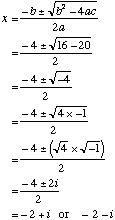|
Most polynomial equations can be solved with an answer from the set of real numbers. However, there are some equations, such as x2 + 1 = 0, which cannot be solved using real numbers. This type of equation can be solved by creating one new number called i. The definition of i is:
Use of the number i allows for the solution of a whole set of equations involving the square roots of negative numbers. Example Solve the quadratic equation x2 + 4x + 5 = 0 using the set of real numbers plus i. Let a = 1, b = 4 and c = 5 Using the quadratic formula: The number system formed by the real numbers with the addition of the number i and including numbers in the form 3 + 5i is called the set of complex numbers. NotationThe set of complex number is denoted by C. Complex numbers are often represented by the variable z where z = a + ib a is called the real part of the complex number z. The real part can be written Re(z). b is called the imaginary part of the complex number z. The imaginary part can be written Im(z). Conjugate The product of a complex number and its conjugate gives a real number. e.g. (3 + 4i)(3 − 4i) = 9 -16i2 = 9 − 16(-1) = 25 |
